
If you look closely, the sign says, “Wrigley Field.” It’s not Chicago’s historic Wrigley, home of the Cubs, who are the current World Series Champions in North America’s National Baseball League. It is on Whidbey Island, off the west coast of Washington State, in the cozy town of Langley. You could take all of the people in the Langley and surrounding area, about 5,000, and fit them eight times into the Wrigley Field of Chicago. This Wrigley is quaint. Deliciously green. Historic in reference, but more likely occupied by characters of the Sandlot.
Near Whidbey’s Wrigley, I and the rest of our working board for The Circle Way have been at a planning meeting and retreat this week. It’s been an essential time together. We took on a mix of three intentions together.
1. Seeing the big picture — the sight of the eagles, a few of which flew not far from our meeting place overlooking Langley’s place on the Puget Sound. It is important that we let ourselves evolve in the place of seeing possibility, of wondering together, of wandering not just in the external grounds of Wrigley, but in the imaginative grounds of how to further help the broad, global community that is The Circle Way.
2. Getting work done — the groundedness of a buffalo. On the earth, in the dirt. Updating webpages. Revisiting budget. Tending to databases. Writing newsletters. It’s chop wood and carry water kinds of stuff.
3. Caring for each other — the softness of a dear. This is hard work, at one layer. There are tears and aches. For the state of the world. For our friends and colleagues. For people and communities that are starving for essential containers like The Circle Way to do everything from restore sanity to provide direction, from grieving together to celebrating thoughtful and essential progression and evolution.
I’m proud of this board. This group of people, that spend four days together in circle to figure out where we are and where we are next headed. To figure out how to be of service in the most sustainable and co-created ways. To be give such thoughtful attention to what this is for and how to further shift a paradigm from competition to cooperation and collaboration – in community and in governance.
It’s historic.
